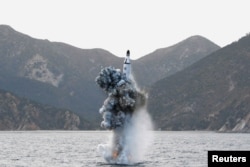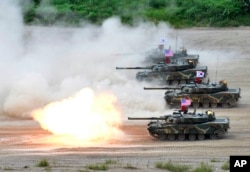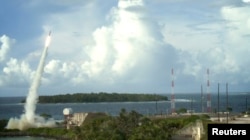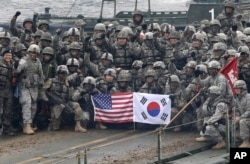North Korea could soon develop a new submarine that will incorporate ongoing ballistic missile advances being made and increasing the military’s capability to carry out a nuclear strike from the sea.
Pyongyang’s recent successful submarine launched ballistic missile (SLBM) test flew 500 kilometers before falling into the sea inside Japan’s air defense identification zone.
It has raised concerns that the North is also working on a new submarine that can fire multiple ballistic missiles.
“The fact that North Korea is making SLBM means it is making a submarine which can deploy the SLBM, and I think they can make the submarine into a nuclear powered submarine,” said Park Hwee-rhak, a political science professor at Kookmin University.
Developing a submarine with nuclear power would allow it to stay underwater for long periods of time, and to travel longer distances at higher speeds while remaining undetected.
Moon Keun-sik, a defense analyst at the Korea Defense Security Forum, said he expects North Korea to build a 3,000-ton submarine with three SLBM launch tubes.
Recent satellite images of the North Korean naval base near Sinpo show a launching way and large construction hall in a secure boat basin, that analysts say could be used to build and launch a new ballistic missile submarine.
Despite the North’s recent progress, the U.S.-Korea Institute at Johns Hopkins University said it is unlikely that any new SLBM capable vessel would become operational before 2020.
Gorae prototype
The North used a prototype Gorae submarine (Gorae is Korean for whale) for its recent SLBM test. It is diesel powered, can stay submerged for a few hours at a time and has only one launch tube that could fire an intermediate range missile.
The rest of North Korea’s fleet of approximately 70 submarines is older, like the Romeo-class submarines built with 1950s technology, and too small for a ballistic missile launch vessel.
North Korea also claims to have developed the capability to miniaturize a nuclear device to fit on a missile warhead, but it has not yet demonstrated the technology.
South Korea
South Korean President Park Geun-hye on Monday ordered her military to develop effective measures to counter the North’s increasing nuclear and missile capabilities.
“I call upon you to maintain a robust posture to retaliate, to make sure that any attempt by the North at engaging in any form of provocation will lead to the self-destruction of the North Korean regime,” Park said.
In Seoul’s National Assembly, some lawmakers have raised concern that the North’s new submarine missile capability, which could strike from anywhere along the coast, could make the U.S. THAAD missile defense system that is aimed northwards ineffective.
They have urged the South Korean military to accelerate the development of a secondary “Kill Chain” missile defense system to defend against possible submarine based missile attacks.
Chung Jin-suk, a leader of ruling Saenuri party has called for the South to deploy its own nuclear powered submarine that can track down and block any incursions from the North.
“[I urge] South Korean military to actively consider deployment of nuclear powered submarine which has a capacity to operate underwater for an extended period of time, a high-tech sonar system, and striking power,” he said.
The South Korea Defense Ministry said it will look into all options but is not considering a nuclear submarine at this time.
Acquiring nuclear submarines is a sensitive issue for South Korea because it could trigger opposition from nations such as the United States and China amid worries about a regional arms race.
Security cooperation
The U.S., which maintains over 28,000 troops in South Korea, and 50,000 troops in Japan, has pledged to defend its allies against a nuclear attack.
The U.S. allies have increased security cooperation and information sharing in the face the growing North Korean threat.
U.S. nuclear submarines also routinely operate in international waters in the region on what the Navy describes as intelligence, surveillance, and reconnaissance missions.
Youmi Kim in Seoul contributed to this report.














